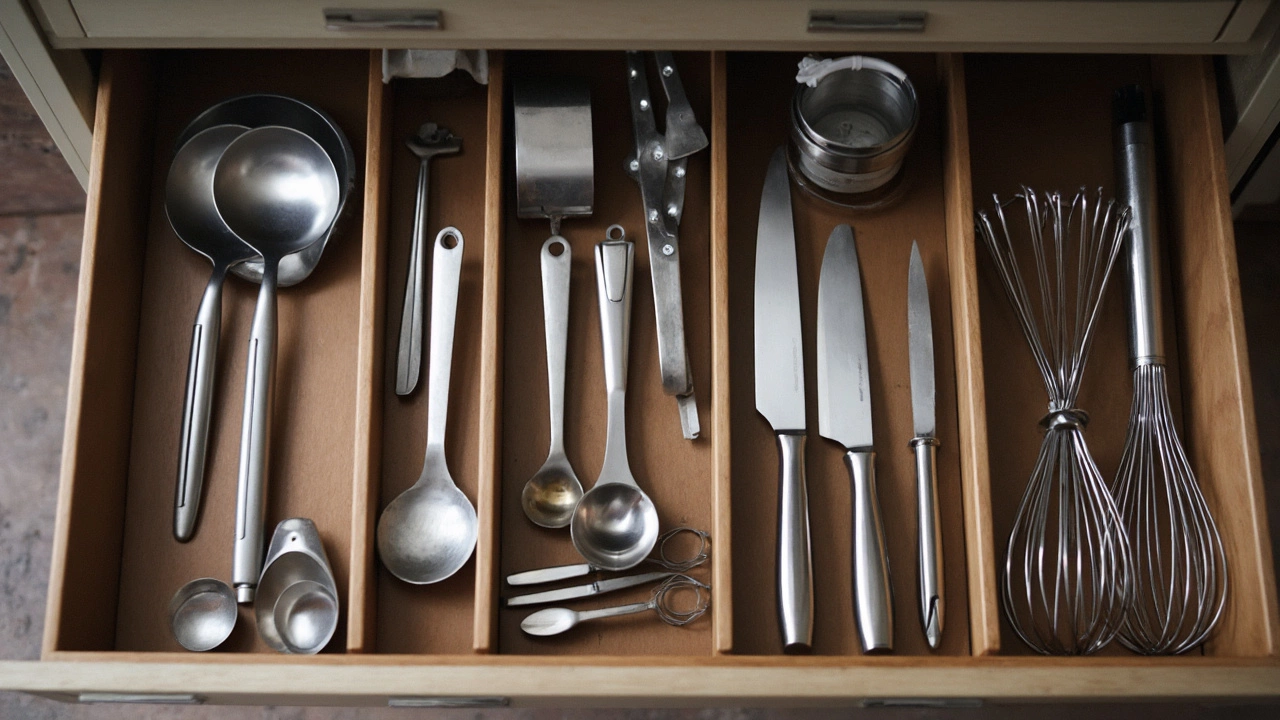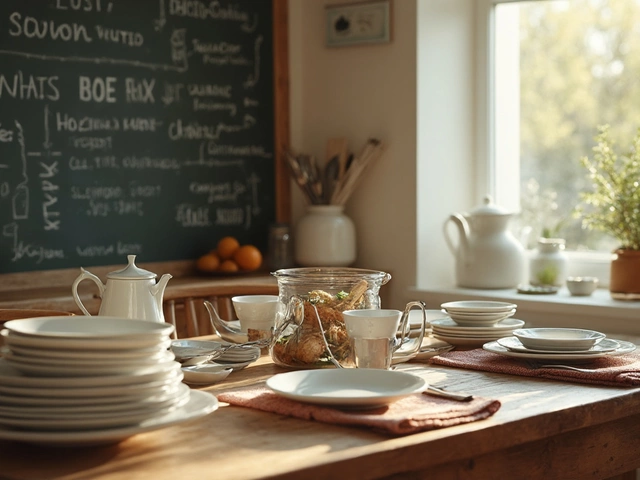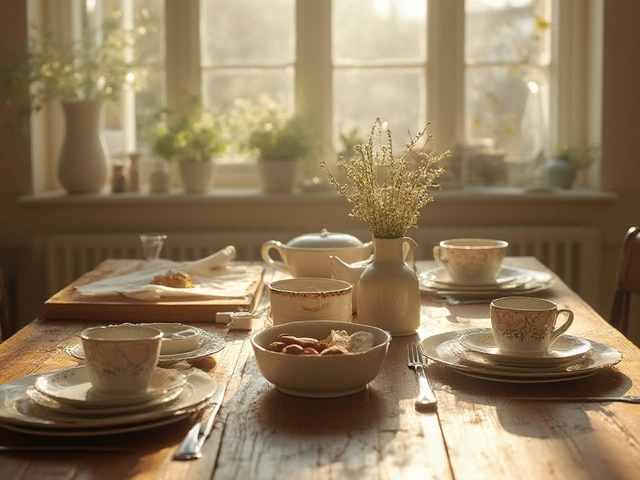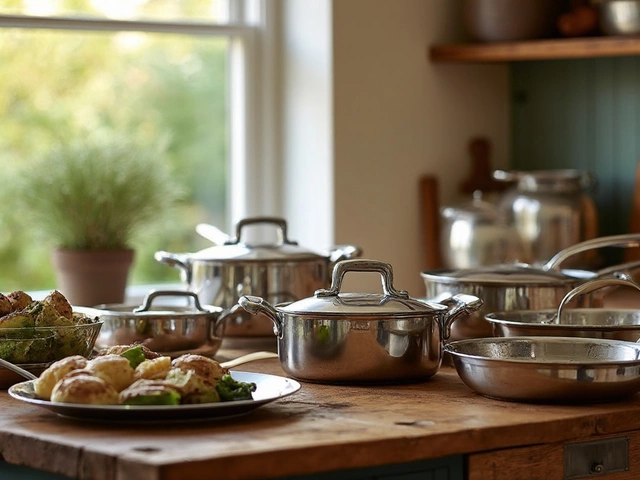The first thing you should do before cooking might be more obvious than you think: get to know your kitchenware. A cluttered workspace and unknown tools can make cooking feel like rocket science. So, let's make it simple.
Start by organizing your workspace. Nothing fancy—just ensure counters are clear and things are within arm's reach. Ever wondered if those mismatched bowls and old pots are holding you back? A clean and tidy workspace adds efficiency and is less stressful.
Next up, let's talk kitchen tools. You don't need a gadget for every single task, but certain basics can make or break your meal prep. Think sharp knives, sturdy cutting boards, and dependable pans. Invest in quality tools that won't wear out after a few meals; they'll pay you back in time saved and frustration avoided.
- Organizing Your Workspace
- Essential Kitchen Tools
- Knife Safety and Maintenance
- Choosing the Right Cookware
Organizing Your Workspace
Before even turning on the stove, organizing your workspace is a crucial step toward efficient cooking. Clutter can be distracting and even make it easier to make mistakes, so keeping things tidy is a game-changer. Here’s how you can transform your kitchen setup:
Clear the Counters
Start by clearing off your counters. You don’t need your toaster, blender, and coffee maker fighting for space while you’re trying to whip up dinner. Designate a specific area for meal prep and keep it free of unnecessary appliances during cooking time.
Gather Your Tools Before Cooking
It sounds simple, but having everything within reach is a lifesaver. Imagine needing a spoon right when your pasta is about to boil over. Avoid the panic and gather all necessary tools such as knives, spatulas, and bowls beforehand.
Designate Zones
Think of your kitchen as a mini restaurant. Designate zones for specific tasks: chopping, baking, cooking, and cleaning. This not only reduces chaos but also makes following complex recipes way easier.
Declutter and Organize Drawers
Drawers can quickly become a black hole for kitchenware. Dedicate some time to rearrange them. Use drawer dividers to keep similar utensils together. You’ll be amazed at how much time you save by not digging around for that one elusive garlic press.
Smart Storage Solutions
If your kitchen is more cramped than you’d prefer, consider utilizing vertical space or investing in smart storage solutions like magnetic knife strips or hanging racks. This keeps items accessible without adding to counter clutter.
Maintain Cleaning Supplies
No one likes cleaning as they cook, but having a cloth and sponge nearby for quick wipe-downs can be a huge time-saver in the long run.
| Task | Estimated Time |
|---|---|
| Clear Counters | 5 minutes |
| Gather Tools | 3 minutes |
| Organize Drawers | 10 minutes |
By following these steps, you set the stage for a stress-free cooking regimen. You’ll spend less time looking for tools and more time focused on creating amazing dishes. Keep it simple, keep it clean, and your cooking experience will improve drastically.
Essential Kitchen Tools
Before you start cooking, having the right kitchenware can mean the difference between a smooth experience and a culinary nightmare. Let’s break down the essentials you shouldn’t do without in any kitchen.
1. Chef's Knife
A good quality chef’s knife is probably the most crucial tool in your arsenal. It should feel comfortable in your hand and be sharp enough to slice through tomatoes with ease. Make sure to maintain it well, using a honing steel to keep the edge keen and ready for action.
2. Cutting Board
Invest in a solid, non-slip cutting board. Try to keep a few on hand, one for veggies and another for raw meat to avoid cross-contamination. Bamboo or plastic boards are great options that are easy to clean and maintain.
3. Measuring Cups and Spoons
Precision can make a big difference in cooking, especially in baking. A reliable set of measuring cups and spoons ensures that your recipe turns out just right. Whether it's a dash of salt or a cup of flour, accurate measurements are crucial.
4. Cookware
- A couple of non-stick frying pans for everyday use.
- A large stockpot for soups and stews.
- A medium-sized saucepan for sauces and grains.
These pieces cover most of your cooking needs. Make sure the handles are secure, and avoid super cheap options that can result in uneven cooking.
5. Mixing Bowls
Your mixing bowl set doesn’t need to be fancy, but it should include a variety of sizes. Stainless steel or glass options are durable and easy to clean.
6. Tongs and Wooden Spoons
Tongs for flipping, grabbing, or tossing and wooden spoons for stirring make cooking much simpler and are gentle on non-stick surfaces. Both are inexpensive and crucial for any kitchen task.
Remember, these tools are an investment in your cooking journey. They're your culinary partners, so choose wisely and take care of them. With the right set, you can tackle any recipe with confidence.

Knife Safety and Maintenance
Let's face it, knives are one of the most important kitchen tools you'll use. But without proper care and handling, they can be both dangerous and ineffective. Caring for your knives properly isn't just about keeping them sharp but ensuring every cooking experience is smooth and safe.
The Basics of Knife Safety
Start by holding the knife properly. Grip the handle firmly and maintain a steady wrist. Always cut away from your body and use a chopping board to avoid accidents. Remember to keep your eyes on what you're doing; distractions can be risky.
- Cooking with sharp knives actually leads to fewer accidents because you apply less pressure and maintain better control.
- Store knives in a block or on a magnetic strip to prevent them from getting dull or causing accidents in a drawer.
- Don't catch a falling knife—instincts might kick in, but it's safer to step back and let it fall.
Maintaining Your Kitchen Knives
Regular maintenance of knives ensures they remain reliable. Sharpening is key, but honing is equally important to keep the blade's edge straight.
- Sharpen knives once every few months. Use a whetstone or a professional service if you're unsure how to do it yourself.
- Hone your knives every couple of uses to keep the blade aligned; this doesn't sharpen it but prolongs the time between sharpening sessions.
- After using, wash knives by hand and dry them immediately. Dishwashers can be harsh on blades, leading to corrosion.
Here's a quick glance at some do's and don't for knife care:
| Do's | Don'ts |
|---|---|
| Sharpen and hone regularly | Leave knives soaking in water |
| Use the right tool for the task | Cut on hard surfaces like glass |
By following these basic tips, you'll ensure your knives remain a crucial ally in your culinary adventures. Remember, taking care of your kitchenware not only keeps you safe but also enhances your cooking skills!
Choosing the Right Cookware
You've probably heard it a million times, but having the right cookware can change your cooking game completely. Let's face it, trying to fry an egg on a sticky pan is a sure way to start your day off wrong. So, what's the deal with cookware?
Understanding Materials
The material of your cookware affects everything—heat distribution, food sticking, and even how long it'll last. The most common choices are stainless steel, nonstick, and cast iron. Stainless steel is durable and great for browning, while nonstick pans are perfect for eggs and pancakes. Cast iron, though heavy, retains heat like no other, making it awesome for searing meats.
Essential Pieces to Have
You don't need a cookware set that costs as much as a small car. Here are a few essentials:
- Nonstick skillet: Perfect for eggs and quick sautés.
- Stainless steel pan: Great for browning meats and making sauces.
- Large pot: Ideal for soups, stews, and pasta.
- Cast iron skillet: Can go from stove to oven, making it versatile for many recipes.
Caring for Your Cookware
Proper care extends the life of your cookware. Avoid metal utensils on nonstick surfaces, and keep your cast iron seasoned to prevent rust. It might seem like extra work, but these habits mean you'll be cooking with your favorite pans for years.
Instead of thinking you need the fanciest tools, focus on how each piece fits into your cooking style. That’s the real secret to happy cooking!



